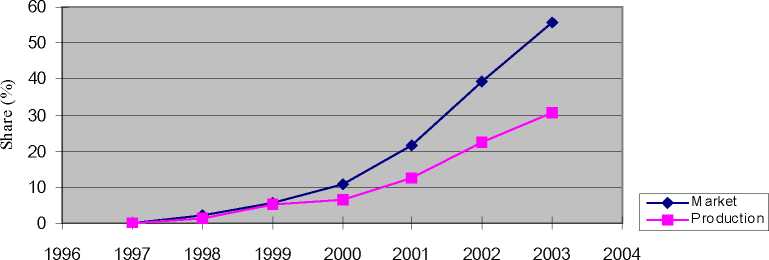to 39.4%. In 2003, China’s domestic firms produced 34.3 million and sold 34.1 million mobile
handsets, taking a majority of China’s mobile handset market with a share of 55.8% (MII, 2004).
In contrast, the share of the four leading foreign-brands, Motorola, Nokia, Siemens, and Ericsson,
declined from more than 85% in 1999 to 46% in 2002, and 24% in 2003 (MII, 2004). Bird has
been a leading producer with the largest market share of all domestic firms since 2000.
According to MII (2004), Bird held 15% of handset market in 2003, and is a major contributor to
lifting the share of Chinese brands to 55.8% in 2003. Overall, ten domestic firms produced more
than one million handsets in 2003.
Figure 3. Growth of market/production share of local-brand handsets (1997-2003)

Year
Source: MII (various years)
Chinese handset makers have successfully narrowed the technology gap with industry
leaders by aggressive investment in manufacturing facilities. After 2002, Chinese handset
manufacturers also significantly increased investment in R&D, focusing on upgrading their
technological capabilities. Bird spent 6% of its revenue on R&D in 2003 (Network Weekly,
2004). But Chinese makers had not yet reached the stage of mastering the core technologies of
handset products. In fact, by the close of 2004 no domestic firm in China has grasped the core
12
China's Mobile Handsets FINAL DRAFT 2006.sph ERSA2006 Greece
More intriguing information
1. The name is absent2. The Macroeconomic Determinants of Volatility in Precious Metals Markets
3. Fiscal Sustainability Across Government Tiers
4. HOW WILL PRODUCTION, MARKETING, AND CONSUMPTION BE COORDINATED? FROM A FARM ORGANIZATION VIEWPOINT
5. Migration and employment status during the turbulent nineties in Sweden
6. Non-causality in Bivariate Binary Panel Data
7. The name is absent
8. The Clustering of Financial Services in London*
9. Social Balance Theory
10. Gender and aquaculture: sharing the benefits equitably